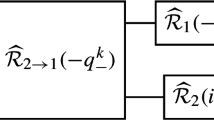Abstract
We attempt to describe a domain using a squeezed state within quantum field theory. An extended squeeze operator is used to construct the state. Using a scalar field theory, we describe a domain in which the distributions of the condensate and of the fluctuation are both Gaussian. The momentum distribution, chaoticity, and correlation length are calculated. It is found that the typical value for the momentum is approximately the inverse of the domain size. It is also found that the chaoticity reflects the ratio of the size of the squeezed region to that of the coherent region. The results indicate that the quantum state of a domain is defined by these quantities under the assumption that the distributions are Gaussian. As an example, this method is applied to a pion field, and the momentum distribution and chaoticity are shown.





Similar content being viewed by others
References
D.F. Walls, G.J. Milburn, Quantum Optics (Springer, Berlin, 1994)
W. Vogel, D.-G. Welsch, Quantum Optics, 3rd., revised and extended edn. (Wiley-VCH, Weinheim, 2006)
H.P. Yuen, Phys. Rev. A 13, 2226 (1976)
D.F. Walls, Nature 306, 141 (1983)
L. Parker, Phys. Rev. 183, 1057 (1969)
D. Boyanovsky, H.J. de Vega, R. Holman, Phys. Rev. D 49, 2769 (1994)
H. Mishra, A.R. Panda, J. Phys. G 18, 1301 (1992)
A. Mishra, P.K. Panda, S. Schramm, J. Reinhardt, W. Greiner, Phys. Rev. C 56, 1380 (1997)
A. Mishra, H. Mishra, J. Phys. G 23, 143 (1997)
T. del Ríogaztelurrutia, A.C. Davis, Nucl. Phys. B 347, 319 (1990)
M. Ishihara, M. Maruyama, F. Takagi, Phys. Rev. C 57, 1440 (1998)
G. Wilk, Z. Włodarczyk, Eur. Phys. J. A 40, 299 (2009)
M. Asakawa, T. Csörgő, M. Gyulassy, Phys. Rev. Lett. 83, 4013 (1999)
S.S. Padula, G. Krein, T. Csörgő, Y. Hama, P.K. Panda, Phys. Rev. C 73, 044906 (2006)
T. Csörgő, S.S. Padula, Braz. J. Phys. 37, 949 (2007)
I.V. Andreev, R.M. Weiner, Phys. Lett. B 373, 159 (1996)
R.D. Amado, I.I. Kogan, Phys. Rev. D 51, 190 (1995)
H. Hiro-Oka, H. Minakata, Phys. Lett. B 425, 129 (1998)
H. Hiro-Oka, H. Minakata, Phys. Lett. B 434, 461(E) (1998)
H. Hiro-Oka, H. Minakata, Phys. Rev. C 61, 044903 (2000)
J. Randrup, Nucl. Phys. A 630, 468c (1998)
S. Aoki, M. Fukugita, S. Hashimoto, K.-I. Ishikawa, N. Ishizuka, Y. Iwasaki, K. Kanaya, T. Kaneda, S. Kaya, Y. Kuramashi, M. Okawa, T. Onogi, S. Tominaga, N. Tsutsui, A. Ukawa, N. Yamada, T. Yoshie, Phys. Rev. D 62, 094501 (2000)
Author information
Authors and Affiliations
Corresponding author
Appendices
Appendix A: Examples of squeeze operators
In this appendix, we give three examples for the squeeze operator.
The first example is given by the following G(k,l): G(k,l)=g(k)δ(k−l). The squeeze operator is obtained by substituting G(k,l) directly:
This is just the operator given by Eq. (2). The function G(k,l) is represented as G(k,l)=|g(k)|e iθ(k) δ(k−l). The Bogoliubov transformation is easily obtained by using Eq. (5b):

The second example is given by the following G(k,l): G(k,l)=g(k)δ(k+l) and G(k,l)=G(l,k). The function G(k,l) is represented as |g(k)|e iθ(k) δ(k+l). The condition that G(k,l)=G(l,k) requires that g(k)=g(−k). The squeeze operator is

The coefficients A 2n (p,k 2n ) defined by Eq. (6a) and B 2n+1(p,k 2n+1) defined by Eq. (6b) are


The transformation of the annihilation operator by the squeeze operator is

The final example is the squeeze operator described by smeared annihilation and creation operators. We use the smeared operators introduced by Andreev and Weiner [16]:
where a A (k) satisfies the relation [a A (k),a A (l)]=(2π)3 δ(k−l). The smearing function f A (x) is the Fourier transformation of f A (k). The integral of |f A (x)|2 is called the effective volume of the particle source.
We attempt to construct the squeeze operator that is described by \(\tilde{a}_{A}(\mathbf{p})\) and \(\tilde{a}^{\dag}_{A}(\mathbf{p})\). We take G(k,l) as follows:
The squeeze operator is obtained by substituting Eq. (A.7) into the expression of the squeezed operator:
Clearly, the operator is obtained by replacing a(k) and a †(k) in Eq. (A.1) by \(\tilde{a}_{A}(\mathbf{k})\) and \(\tilde{a}^{\dag}_{A}(\mathbf{k})\), respectively.
Appendix B: Equivalence of two squeezed states
A squeezed state is defined as |sq〉=D(α)S(G)|0〉. On the other hand, another definition exists, \(|\overline{\mathrm{sq}}\rangle= S(G)D(\beta)|0\rangle\). In this section, we attempt to show the relationship between these two states when G(k,l)=g(k)g(l).
We prove here that the state \(|\overline{\mathrm{sq}}\rangle\) is an eigenstate of the operator b(p), which is defined by b(p)=S(G)a(p)S †(G). By applying the operator b(p) on the state \(|\overline{\mathrm{sq}}\rangle\), we obtain

It can be shown that \(|\overline{\mathrm{sq}}\rangle\) is an eigenstate of the operator b(p) using the relation D †(β)a(p)D(β)=a(p)+β(p):
Next, we consider the state b(p)|sq〉:

Therefore, |sq〉 is identical to \(|\overline{\mathrm{ sq}}\rangle\) when the following condition is satisfied:

Rights and permissions
About this article
Cite this article
Ishihara, M. Description of a domain using a squeezed state in a scalar field theory. Eur. Phys. J. C 73, 2423 (2013). https://doi.org/10.1140/epjc/s10052-013-2423-9
Received:
Revised:
Published:
DOI: https://doi.org/10.1140/epjc/s10052-013-2423-9




